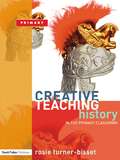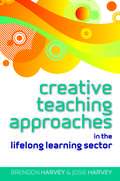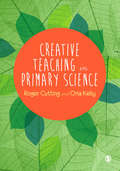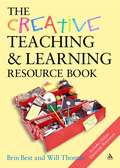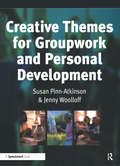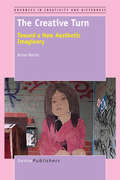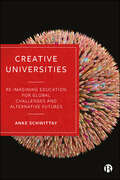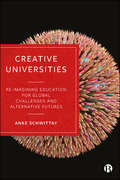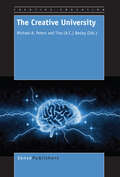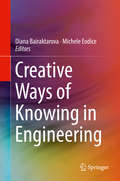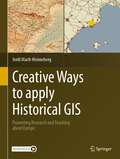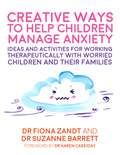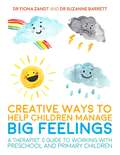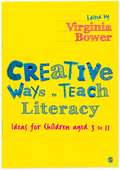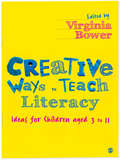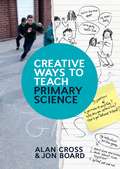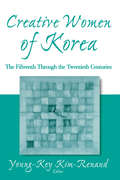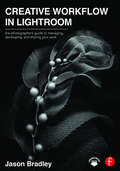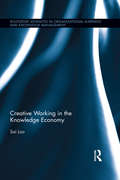- Table View
- List View
Creative Teaching: History in the Primary Classroom
by Rosie Turner-BissetDesigned specifically for teachers with little subject knowledge or experience in history, this book provides trainees with the confidence they need to teach primary history. Based on Curriculum 2000, the book provides valuable step-by-step guidance on how to create, plan, develop, organize and assess high-quality teaching activities in primary history. This book: is full of teaching approaches, practical ideas, teaching activities, real-life case studies and vignettes of good teaching practice; covers both conventional and modern approaches - such as drama, role-play, story telling, music and dance; and explains how each approach can be adapted to suit all primary ages and abilities. Children with a range of learning needs and styles respond with enthusiasm to a wide variety of teaching approaches - and this book provides trainee teachers with that repertoire and variety.
Creative Teaching Approaches in the Lifelong Learning Sector (UK Higher Education OUP Humanities & Social Sciences Education OUP)
by Brendon Harvey Josie HarveyThis practical book explores creative ways of teaching and learning in the lifelong learning sector and provides a toolkit of creative teaching approaches with the potential to transform your teaching practice. Drawing on various techniques and diverse environments the book illustrates a variety of approaches, offering insights and conclusions drawn from a rich range of practice examples and highlighting the potential pitfalls of creative practices. The book tackles crucial issues such as:The characteristics of a creative tutorBoosting your creative confidence, and that of your learnersCreative methods to excite and engage learnersConstructing a creative sessionDeveloping resilience and self-care strategiesThroughout the book there are activities, reflection points and extension tasks, as well as the frequent use of symbols and cross-referencing notes to help you see the links between sections. Creative Teaching Approaches in the Lifelong Learning Sector will appeal to trainee and experienced teachers working in the lifelong learning sector, including further and higher education, work-based learning, and adult and community settings. “So much more than a manual or menu of how to bring creativity into teaching, this book will be refreshing for experienced lecturers, trainers and teachers, and an inspirational as well as reassuring font of ideas for those new to the role. In addition to presenting practical ideas for individuals to use, Brendon Harvey and Josie Harvey’s book is uniquely valuable in addressing institutional challenges that can face those introducing new creative ways of working, as well as providing counsel on how the lecturer/trainer/teacher can protect their own well-being when stepping into creative territory.”Dr Clare Rigg, Head of Department of Business, Hotel, Catering & Tourism, Institute of Technology Tralee, County Kerry, Ireland“Brendon and Josie have drawn on their wealth of experience to co-author a practical teaching guide to meet the needs of 21st century learners in the Lifelong Learning Sector.It is an excellent guide for both those new to teaching and also those seeking to meet the challenges of becoming more creative and using new technologies and social media more effectively in their professional practise. For the new teacher, there is a welcoming section addressing some of the anxieties which may be present before and during the early stages of practise as well as great examples of what to include in a creative session without breaking the bank! The final section focuses on creativity within the organisational context and introduces us to the 'Trojan Mouse' and the benefits of action research.This is a recommended read for anyone looking to update their practice.”Debbie Fletcher, Vice Principal of Leeds City College“Drawing on their own experiences, as shared with us in the stories of their respective journeys from the world of traditional teaching and training methods and environments to that of creative active engagement of and with learners, the Harveys provide valuable insights into and a practical guide for learning facilitators in a variety of contexts to take or enhance their own journeys into the use of Creative Approaches in the Lifelong Learning Sector. Complete with stories, cases, and examples supported by provocative thinking points and activities and exercises for learning facilitators, this is a must-have resource. Consistent with their message, this is a creatively written and presented practical guide that inspires outside-the-box thought and action eschewing any attempts to provide “recipes” but rather championing the need for diversity of methods and approaches based on learners, setting, context, and other variables.”Tony G. LeTrent-Jones, Adjunct Professor, University of North Carolina, USA, and Elon University, USA
Creative Teaching in Primary Science
by Roger Cutting Orla KellyCreative teaching has the potential to inspire deep learning, using inventive activities and stimulating contexts that can capture the imagination of children. This book enables you to adopt a creative approach to the methods and content of your primary science teaching practice and confidently develop as a science educator. Key aspects of science teaching are discussed, including: planning for teaching and learning assessing primary science cross-curricular approaches the intelligent application of technology sustainability education outdoor learning Coverage is supported by illustrative examples, encouraging you to look at your own teaching practice, your local community and environment, your own interests and those of your children to deepen your understanding of what constitutes good science teaching in primary schools. This is essential reading for students on primary initial teacher education courses, on both university-based (BEd, BA with QTS, PGCE) and schools-based (School Direct, SCITT) routes into teaching. Dr Roger Cutting is an Associate Professor in Education at the Institute of Education at Plymouth University. Orla Kelly is a Lecturer in Social, Environmental and Scientific Education in the Church of Ireland College of Education.
Creative Teaching in Primary Science (PDF)
by Roger Cutting Orla KellyCreative teaching has the potential to inspire deep learning, using inventive activities and stimulating contexts that can capture the imagination of children. This book enables you to adopt a creative approach to the methods and content of your primary science teaching practice and confidently develop as a science educator. Key aspects of science teaching are discussed, including: planning for teaching and learning assessing primary science cross-curricular approaches the intelligent application of technology sustainability education outdoor learning Coverage is supported by illustrative examples, encouraging you to look at your own teaching practice, your local community and environment, your own interests and those of your children to deepen your understanding of what constitutes good science teaching in primary schools. This is essential reading for students on primary initial teacher education courses, on both university-based (BEd, BA with QTS, PGCE) and schools-based (School Direct, SCITT) routes into teaching. Dr Roger Cutting is an Associate Professor in Education at the Institute of Education at Plymouth University. Orla Kelly is a Lecturer in Social, Environmental and Scientific Education in the Church of Ireland College of Education.
The Creative Teaching & Learning Resource Book
by Brin Best Will ThomasAn exciting mixed product of print and downloadalbe resources, this book presents over 200 tips, tools and practical strategies for more effective teaching and learning that can be used in your classroom tomorrow. The emphasis is on exciting, inclusive learning experiences which genuinely engage learners and raise motivation. The book is a follow up to the ground-breaking Creative Teaching and Learning Toolkit which sets out the key principles of effective teaching and learning.Using their pioneering Creative Teaching Framework as a scaffold for the book, award-winning authors Brin Best and Will Thomas guide you through strategies that deal with each component of effective teaching. As well as dealing comprehensively with actual teaching techniques you can use, the authors also tackle the key areas of vision, climate and reflection, showing you how a range of practical approaches can also benefit your learners. A special section deals with things you can do on a personal and professional level to improve your teaching skills too.All the strategies included in the book are highly practical and represent tried and tested approaches from successful classrooms. Each is presented concisely, showing how you can embed the learning activities into your day to day lessons. Special emphasis is placed on creative ways of producing successful learning outcomes for students of all abilities.This resource book presents a rich compendium of teaching and learning strategies that can be used by teachers of all subjects. It will help you to become more creative in your teaching and for learners to be more creative in their approaches. It will widen your repertoire of teaching approaches, to the benefit of all your learners. Whether you are a teacher early in your career looking to gain new skills, or an experienced practitioner wishing to expand your toolkit and freshen up your teaching, then the Creative Teaching and Learning Resource Book has something for you.
Creative Themes for Groupwork and Personal Development
by Susan Pinn-Atkinson Jenny WoolloffBased around thirty themes, this practical resource provides flexible and adaptable ideas for groupwork sessions. The themes in this book: can be adapted and developed to match the exact needs and interests of the participants; aim to generate and inspire group facilitators to think broadly and creatively, and to feel confident in using the culture and history of their geographical area to enrich the work they do with participants; enable participants to explore, develop and reflect upon their hidden, unidentified or unacknowledged strengths, transferable skills and knowledge; have a variety of alternative or additional ideas, and many are accompanied by worksheets; and include colour, television, soaps, touch, mirrors, maps, weather and many more.
Creative Themes for Groupwork and Personal Development
by Susan Pinn-Atkinson Jenny WoolloffBased around thirty themes, this practical resource provides flexible and adaptable ideas for groupwork sessions. The themes in this book: can be adapted and developed to match the exact needs and interests of the participants; aim to generate and inspire group facilitators to think broadly and creatively, and to feel confident in using the culture and history of their geographical area to enrich the work they do with participants; enable participants to explore, develop and reflect upon their hidden, unidentified or unacknowledged strengths, transferable skills and knowledge; have a variety of alternative or additional ideas, and many are accompanied by worksheets; and include colour, television, soaps, touch, mirrors, maps, weather and many more.
The Creative Turn: Toward a New Aesthetic Imaginary (Advances in Creativity and Giftedness #6)
by Anne M. HarrisThe conundrum of understanding, practising and teaching contemporary creativity is that it wants to be all things to all people. Almost all modern lists of creativity, creative thinking and how-to ‘becoming creative’ books begin with one premise: the creative individual/artist is not special, rather each of us is creative in a special way and these skills can – and must - be nurtured. Increasingly, industry and education leaders are claiming that creativity is the core skill to take us into a prosperous future, signalling the democratisation of creativity as industry. Yet centuries of association between aesthetics, mastery and creativity are hard to dismantle. These days, it is increasingly difficult to discuss creativity without reference to business, industry and innovation. Why do we love to think of creativity in this way and no longer as that rare visitation of the muse or the elite gift of the few? This book looks at the possibility that creativity is taking a turn, what that turn might be, and how it relates to industry, education and, ultimately, cultural role of creativity and aesthetics for the 21st century. In proliferating discourses of the commodification of creativity, there is one thing all the experts agree on: creativity is undefinable, possibly unteachable, largely unassessable, and becoming the most valuable commodity in 21st-century markets.
Creative Universities: Reimagining Education for Global Challenges and Alternative Futures
by Anke SchwittayHow can higher education contribute to tackling today’s complex challenges? In this wide-ranging book, Anke Schwittay argues that, in order to inspire and equip students to generate better responses to global challenges, we need a pedagogy that develops their imagination, creativity, emotional sensibilities and practical capabilities. Schwittay proposes a critical-creative pedagogy that incorporates design-based activities, experiential teaching, serious play and future-oriented practices. Crucially, she demonstrates the importance of moving beyond analysing limitations to working towards alternatives for more equitable, just and sustainable futures. Presenting concrete ideas for the reimagination of higher education, this book is an essential read for both educators and students in any field studying global challenges.
Creative Universities: Reimagining Education for Global Challenges and Alternative Futures
by Anke SchwittayHow can higher education contribute to tackling today’s complex challenges? In this wide-ranging book, Anke Schwittay argues that, in order to inspire and equip students to generate better responses to global challenges, we need a pedagogy that develops their imagination, creativity, emotional sensibilities and practical capabilities. Schwittay proposes a critical-creative pedagogy that incorporates design-based activities, experiential teaching, serious play and future-oriented practices. Crucially, she demonstrates the importance of moving beyond analysing limitations to working towards alternatives for more equitable, just and sustainable futures. Presenting concrete ideas for the reimagination of higher education, this book is an essential read for both educators and students in any field studying global challenges.
The Creative University (Creative Education)
by Michael A. Peters Tina A. C. BesleyThe concept of the “Creative University” signals that higher education stands at the center of the creative economy indicating the growing significance of intellectual capital and innovation for economic growth and cultural development. Increasingly economic activity is socialised through new media and depends on immaterial and digital goods. This immaterial economy includes new international labour markets that demand analytic skills, global competencies and an understanding of markets in tradeable knowledges. Delivery modes in education are being reshaped. Global cultures are spreading in the form of knowledge and research networks. Openness, networking, cross-border people movement, flows of ideas, capital and scholars are changing the conditions of imagining and producing creative work. The economic aspect of creativity refers to the production of new ideas, aesthetic forms, scholarship, original works of art and cultural products, as well as scientific inventions and technological innovations. It embraces both open source communication as well as commercial intellectual property. This collection explores these ideas as the basis for a new development agenda for universities.
Creative Ways of Knowing in Engineering
by Diana Bairaktarova Michele EodiceThis book offers a platform for engineering educators who are interested in implementing a “creative ways of knowing” approach to presenting engineering concepts. The case studies in this book reveal how students learn through creative engagement that includes not only design and build activities, but also creative presentations of learning, such as composing songs, writing poems and short stories, painting and drawing, as well as designing animations and comics. Any engineering educator will find common ground with the authors, who are all experienced engineering and liberal arts professors, who have taken the step to include creative activities and outlets for students learning engineering.
Creative Ways to apply Historical GIS: Promoting Research and Teaching about Europe
by Jordi Martí-HennebergThis volume promotes the use of Historical GIS (H-GIS) for both education and research. It consists of a coherent set of chapters that allow readers to study the spatial histories of cities, infrastructure, landscapes, and more across Europe. Each chapter is accompanied by Electronic Supplementary Material (ESM) including GIS data, guides and complementary material in .pdf format, and more. To date, there are no similar materials available in this field compiled in a single book. Interdisciplinarity in spatial research is a main theme of this volume, and the text and tools provided here allow readers to combine inputs relating to the study of earth sciences, population, urban growth and transportation, focusing on changes over both space and time. Each chapter provides data in GIS format and also a user's guide to enable readers to deeply engage with the contents themselves. Guidelines are provided to help locate new data about other areas of the world, which users will be able to develop independently. The book is divided into three parts, each presenting different scales of study and analysis at the local, regional and national levels. Part One deals with general subjects analyzed across large areas, mainly within Europe. Part Two provides more specific subjects and data. Part Three covers sources and teaching with H-GIS. The book will be of interest to researchers, academics, teachers and students from secondary schools up to university level. Each subject and tutorial is aimed at a multi-level audience.
Creative Ways to Help Children Manage Anxiety: Ideas and Activities for Working Therapeutically with Worried Children and Their Families
by Fiona Zandt Suzanne BarrettThis book sets out therapeutic activities to help children aged 4-12 years and their families to better understand and manage anxiety. It explains how to work with anxious children, providing a framework for assessment and therapy that draws on CBT, ACT and narrative therapy approaches. Lots of practical tips for therapists are included and important developmental considerations are discussed, including adapting therapy for children with developmental difficulties, and working with families and schools.Over 50 playful therapeutic activities are included, which have been developed through the authors' extensive work with children, giving children an arsenal of coping strategies. They focus on key areas such as understanding anxiety, managing anxious thoughts, and building resilience and use readily available, inexpensive materials and downloadable templates which are provided in the book. This is the perfect tool for therapists looking for playful and purposeful ways to work with children with anxiety.
Creative Ways to Help Children Manage Anxiety: Ideas and Activities for Working Therapeutically with Worried Children and Their Families
by Fiona Zandt Suzanne BarrettThis book sets out therapeutic activities to help children aged 4-12 years and their families to better understand and manage anxiety. It explains how to work with anxious children, providing a framework for assessment and therapy that draws on CBT, ACT and narrative therapy approaches. Lots of practical tips for therapists are included and important developmental considerations are discussed, including adapting therapy for children with developmental difficulties, and working with families and schools.Over 50 playful therapeutic activities are included, which have been developed through the authors' extensive work with children, giving children an arsenal of coping strategies. They focus on key areas such as understanding anxiety, managing anxious thoughts, and building resilience and use readily available, inexpensive materials and downloadable templates which are provided in the book. This is the perfect tool for therapists looking for playful and purposeful ways to work with children with anxiety.
Creative Ways to Help Children Manage BIG Feelings: A Therapist's Guide to Working with Preschool and Primary Children (PDF)
by Dr Fiona Zandt Dr Lesley Bretherton Dr Suzanne BarrettTo be able to effectively offer therapy to children, complex therapeutic concepts need to be presented in an appropriate and engaging manner. This practical guide provides clinicians with a way in which to do so, with numerous games and imaginative activities to help children aged 4-12 to express and understand their feelings. Part I provides a comprehensive guide to working therapeutically with children and families, while Part II outlines 47 creative therapeutic activities. Each activity is presented with clear instructions using inexpensive and readily available resources and the objective and rationale of each activity is given, making it easily applicable. Activities range from using an easy to make volcano to help children better understand anger, to using a ball of string to illustrate how one person's feelings affect the whole family. This book is an invaluable resource for newly qualified clinicians, and also a treasure trove of creative ideas for experienced therapists.
Creative Ways to Teach Literacy: Ideas for Children aged 3 to 11 (PDF)
by Virginia BowerShortlisted for the UKLA Academic Book Award 2013! Covering the essential areas of practice, this book suggests ways to make your literacy teaching as creative and engaging as possible. Children get the most out of their learning when it is exciting, and this book offers great ideas for classroom practice, whilst making careful links to research. Sections advise on teaching narrative, poetry and non-fiction, and each chapter contains case studies and ideas to try out in practice. The authors cover a broad range of topics, including: - exploring traditional tales - writing from experience - using playground games as a foundation for literacy - performing poetry. Written for teachers working with children aged 3-11 years, this book gives you the opportunity to develop children's literacy in enjoyable and interesting ways.
Creative Ways to Teach Literacy: Ideas for Children aged 3 to 11
by Virginia BowerShortlisted for the UKLA Academic Book Award 2013! Covering the essential areas of practice, this book suggests ways to make your literacy teaching as creative and engaging as possible. Children get the most out of their learning when it is exciting, and this book offers great ideas for classroom practice, whilst making careful links to research. Sections advise on teaching narrative, poetry and non-fiction, and each chapter contains case studies and ideas to try out in practice. The authors cover a broad range of topics, including: - exploring traditional tales - writing from experience - using playground games as a foundation for literacy - performing poetry. Written for teachers working with children aged 3-11 years, this book gives you the opportunity to develop children's literacy in enjoyable and interesting ways.
Creative Ways to Teach Primary Science (UK Higher Education OUP Humanities & Social Sciences Education OUP)
by Alan Cross Jon BoardDo you need quick and easy access to great ideas for teaching primary science? If so then this is the book for you!Creative Ways to Teach Primary Science draws on the best ideas about teaching primary science, using an evidence-based approach which recognizes that there are some proven and more effective methods for teaching primary science. Creativity is one of the most powerful indicators of successful teaching, and the key is a willingness to take risks and to accept uncertainty. This can be tricky for busy teachers, so this book lends you a helping hand! The authors explain why the methods presented are successful and encourage you to apply these creative techniques to new situations. The book:Offers a handy 'one stop shop' of creative ideas for teaching primary science Provides a 'helping hand' for you to get started in the classroom by presenting a range of teaching methods that are proven to work Encourages creativity and experimentation, regularly recognized as features of outstanding teachingInspires you to develop all the ideas for yourselfProviding a highly practical and accessible handbook to the creative aspects of teaching and learning primary science, this is invaluable reading for trainee and practising primary teachers.
Creative Women of Korea: The Fifteenth Through the Twentieth Centuries
by Young-Key Kim-RenaudThis book introduces important contributions in the humanities by a select group of traditional and modern Korean women, from the 15th through the 20th centuries. The literary and artistic works of these women are considered Korean classics, and the featured artists and writers range from a queen, to a courtesan, to a Buddhist nun, to unknown women of Korea. Although women's works were generally meant only to circulate among women, these creative expressions have caught the attention of literary and artistic connoisseurs. By bringing them to light, the book seeks to demonstrate how Korean women have tried to give their lives meaning over the ages through their very diverse, yet common artistic responses to the details and drama of everyday life in Confucian Korea. The stories of these women and their work give us glimpses of their personal views on culture, aesthetics, history, society, politics, morality, and more.
Creative Women of Korea: The Fifteenth Through the Twentieth Centuries
by Young-Key Kim-RenaudThis book introduces important contributions in the humanities by a select group of traditional and modern Korean women, from the 15th through the 20th centuries. The literary and artistic works of these women are considered Korean classics, and the featured artists and writers range from a queen, to a courtesan, to a Buddhist nun, to unknown women of Korea. Although women's works were generally meant only to circulate among women, these creative expressions have caught the attention of literary and artistic connoisseurs. By bringing them to light, the book seeks to demonstrate how Korean women have tried to give their lives meaning over the ages through their very diverse, yet common artistic responses to the details and drama of everyday life in Confucian Korea. The stories of these women and their work give us glimpses of their personal views on culture, aesthetics, history, society, politics, morality, and more.
Creative Workflow in Lightroom: The photographer’s guide to managing, developing, and sharing your work
by Jason BradleyAdobe’s Lightroom has emerged as a must-have software due to its powerful editing tools and time saving organizational capabilities but how you establish a personalized, creative workflow that optimizes this technology, your time, and your art eludes most photographers. Jason Bradley, award-winning photographer and Lightroom pro, shares the answers to these questions in this practical and easy to follow guide that taps into the "how" and the "why" of a professional photographer’s creative workflow in Lightroom. Bradley will show you how all workflows can be simplified into three steps: establishing, managing, and rendering the file, alongside stunning photographs and explanations from his own experiences. This book will not only teach you how to work within Lightroom but, ultimately, how to make Lightroom work for you.
Creative Workflow in Lightroom: The photographer’s guide to managing, developing, and sharing your work
by Jason BradleyAdobe’s Lightroom has emerged as a must-have software due to its powerful editing tools and time saving organizational capabilities but how you establish a personalized, creative workflow that optimizes this technology, your time, and your art eludes most photographers. Jason Bradley, award-winning photographer and Lightroom pro, shares the answers to these questions in this practical and easy to follow guide that taps into the "how" and the "why" of a professional photographer’s creative workflow in Lightroom. Bradley will show you how all workflows can be simplified into three steps: establishing, managing, and rendering the file, alongside stunning photographs and explanations from his own experiences. This book will not only teach you how to work within Lightroom but, ultimately, how to make Lightroom work for you.
Creative Working in the Knowledge Economy (Routledge Advances in Organizational Learning and Knowledge Management)
by Sai LooThere is a growing interest in the knowledge economy, and the new types of job and ways of working associated with it. This book analyses how a particular group – creative knowledge workers – carry out their jobs and learn within it. Using empirical research from advertising and software development in Europe, Singapore and Japan, it develops a new conceptual framework to analyse the complexities of creative knowledge work. Focussing uniquely on the human element of working in the knowledge economy, it explores the real world of how people work in this emerging phenomenon and examines relationships between knowledge and creative dimensions to provide new frameworks for learning and working. It offers critical insights into how these workers apply their creative knowledge work capacities towards the production of innovative products and services, as well as using their creative abilities and knowledge to fashion both digital and tangible goods in the knowledge economy. Adding significantly to the on-going debate around knowledge work and creativity, this comprehensive examination will be of interest to researchers and educators in organisational learning, management and HRM and to anyone involved in devising ways to develop and support workers in lifelong and flexible creative work practices.
Creative Working in the Knowledge Economy (Routledge Advances in Organizational Learning and Knowledge Management)
by Sai LooThere is a growing interest in the knowledge economy, and the new types of job and ways of working associated with it. This book analyses how a particular group – creative knowledge workers – carry out their jobs and learn within it. Using empirical research from advertising and software development in Europe, Singapore and Japan, it develops a new conceptual framework to analyse the complexities of creative knowledge work. Focussing uniquely on the human element of working in the knowledge economy, it explores the real world of how people work in this emerging phenomenon and examines relationships between knowledge and creative dimensions to provide new frameworks for learning and working. It offers critical insights into how these workers apply their creative knowledge work capacities towards the production of innovative products and services, as well as using their creative abilities and knowledge to fashion both digital and tangible goods in the knowledge economy. Adding significantly to the on-going debate around knowledge work and creativity, this comprehensive examination will be of interest to researchers and educators in organisational learning, management and HRM and to anyone involved in devising ways to develop and support workers in lifelong and flexible creative work practices.
